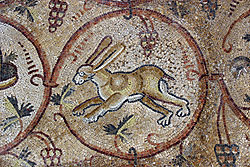1,500-year-old Mosaic Floor Unveiled in Ancient
Synagogue Ruins
by Hana Levi Julian (Israel NN.com)
A spectacular 1,500-year-old mosaic floor in an ancient synagogue
in the Negev Desert, south of Jerusalem, was unveiled to the public
in April 2009.

The mosaic, which is part of a synagogue from the Byzantine period
(fifth and sixth centuries AD) is located in the community of Ma'on-Nirim.
A stunning portrayal of symbols from the period, the 3.70 x 7.80-meter
Byzantine work of art is decorated with a seven-branched menorah
and the images of various animals common to the area, among them
the Lion of Judah.
Scenes of everyday life, including wine production from the surrounding
vineyards, grace the medallions that dance along a vine winding
around the floor.
Archaeologists said that the coins, bone and metal artifacts that
were found on the floor probably belonged to the Holy Ark and the
ornamental curtain in front of the ark. Fragments of glass and ceramic
lamps were also present, as were dozens of amulets, some of which
were related to women who were asking for good health.

A large panel with an Aramaic inscription is also incorporated
into the mosaic itself, the upper part of which blesses all of the
community, followed by a dedication to three individuals who donated
generous contributions.
Similar mosaics and panels have been found in synagogue ruins in
Susya and at an archaeological site in the national park at Ein
Gedi as well.
A special ceremony was held on Monday by the Israel Antiquities
Authority, the Eshkol Regional Council and the Jewish National Fund
to officially inaugurate the new tourist attraction.
The mosaic floor and the remains of the synagogue were first discovered
during salvage excavations that were undertaken on behalf of the
Department of Antiquities in 1957. It was damaged when the road
to Kibbutz Nir Oz was paved that year.
However, the condition of the mosaic deteriorated in recent years
as a result of the unsuitable conditions in which the piece was
kept, and a lack of maintenance.
In 2006 it was removed from the site and transferred for treatment
to the conservation laboratories at the Rockefeller Museum in Jerusalem.
The conservation work on the mosaic and the archaeological remains
of the ancient synagogue was carried out by a team of mosaic conservators
with the Conservation Department of the Israel Antiquities Authority.
New signage, access roads, walking paths with disabled access and
a new entrance to the site have all been created with special funding
by Sandy Galet. Future development plans for the site include a
picnic area and walking paths in the nearby forest. The entrance
to the new-ancient mosaic and archaeological remains of the ancient
synagogue may be accessed from Highway 232.

Photos by Niki Davidov, courtesy of Israel Antiquities Authority.
|




